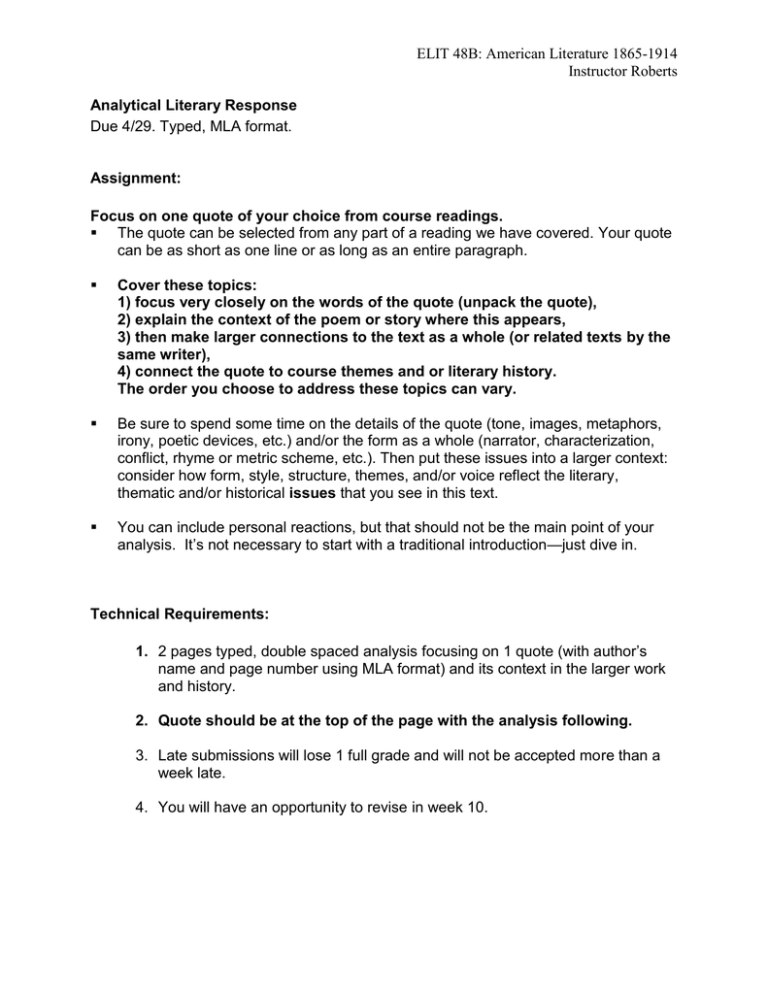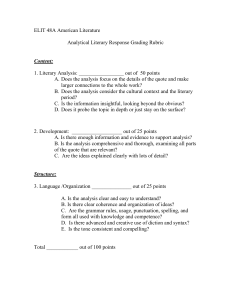Literary Response Essay Assignment
advertisement

ELIT 48B: American Literature 1865-1914 Instructor Roberts Analytical Literary Response Due 4/29. Typed, MLA format. Assignment: Focus on one quote of your choice from course readings. The quote can be selected from any part of a reading we have covered. Your quote can be as short as one line or as long as an entire paragraph. Cover these topics: 1) focus very closely on the words of the quote (unpack the quote), 2) explain the context of the poem or story where this appears, 3) then make larger connections to the text as a whole (or related texts by the same writer), 4) connect the quote to course themes and or literary history. The order you choose to address these topics can vary. Be sure to spend some time on the details of the quote (tone, images, metaphors, irony, poetic devices, etc.) and/or the form as a whole (narrator, characterization, conflict, rhyme or metric scheme, etc.). Then put these issues into a larger context: consider how form, style, structure, themes, and/or voice reflect the literary, thematic and/or historical issues that you see in this text. You can include personal reactions, but that should not be the main point of your analysis. It’s not necessary to start with a traditional introduction—just dive in. Technical Requirements: 1. 2 pages typed, double spaced analysis focusing on 1 quote (with author’s name and page number using MLA format) and its context in the larger work and history. 2. Quote should be at the top of the page with the analysis following. 3. Late submissions will lose 1 full grade and will not be accepted more than a week late. 4. You will have an opportunity to revise in week 10. Example Analytical Literary Response Becky Thatcher ELIT 48B Jan. 18, 2012 Literary Response 1 My Life had stood – a Loaded Gun – In Corners – till a Day The Owner passed – identified – And carried Me away -- (Dickinson, 89) This poem carries the metaphor of the loaded gun all the way to the end, so it’s important to have a firm grasp on that gun and what it means. She says it’s her “life”— not herself, but her life. My life is everything I do: sleep, eat, drive to school, read, talk to people, grade papers, etc. She is looking at what she used to do, and saying it was basically just standing in the corner. I think we can look at her biography and agree since she lived in her father’s house and hardly left at all. If sitting around at Dad’s house were her whole life, I’d say she really was just standing around in corners, in storage. However, the owner of that life looked at it, recognized its purpose and decided to pick it up and use it. Thank goodness. She thinks of her life as a loaded gun—powerful, potentially explosive. Why? I think that the gun stands for her work as a writer. It’s a bold statement that ends with her claiming that her poetry has, “The power to kill/ Without – the power to die,” essentially claiming immortality as a poet (Dickinson 90). A larger context will help to solidify the connection of gun to poetry. She writes so many poems where she stares unflinching at death, where she refuses the comfort of easy piety and won’t pretend certainty about an afterlife. She points her “Yellow Eye,” as she calls the mouth of the gun, at the moment of death and doesn’t flinch, even when the objective reality is “a fly” buzzing around the corpse (poem # 591). In her work as a poet, she focuses on death and mortality with precision and refuses to cloud perception with sentimentality. She shows us the coffin and the grave, the beads of anguish and the final throes, things that we can see and know, not angels in the land of milk and honey. At the same time, as a gun/poet, she takes pleasure in the hunt and smiles “cordial light/Opon the Valley” as she does in many poems where she just wallows in nature. For example, in the poem “A Bird Came down the Walk,” she zooms in to bring tiny creatures into close focus: the beetle, the “frightened beads” of the bird’s darting eyes, the drops of dew the bird drinks. Each creature has such intensity of energy; none is anthropomorphized (well, not much). Instead, each creature focuses on its own life as an animal, disregarding any supposed relationship with humans. The poet/gun’s pleasure in nature is not an imaginary communion with the birds and trees, but a precise study of nature’s indifference and difference from us. This is more objective than sentimental, more like looking down the barrel of a gun than through rose-colored glasses. It’s also interesting that the gun’s owner is a male. She often speaks through invented personae, so that’s not a big surprise, but still it’s telling that to embrace her power and ruthlessness as a poet—and she is ruthless—she must make the gun/poet’s owner male. In her culture (and probably in ours) it’s easier to imagine that kind of power and agency in the hands of a man, so she just goes ahead and speaks as one. Why not? We have multitudes inside us; as Disckinson says, “The Brain – is wider than the Sky” (Dickinson 88).

